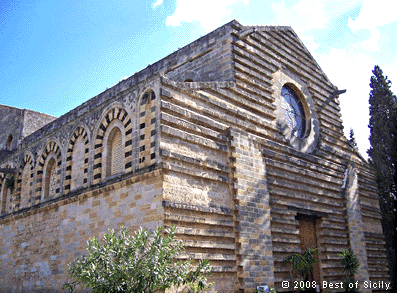Church of the Holy Spirit (Sicily)
Daughter monasteries
Holy Trinity Abbey di Palermo ( uncertain)
Santo Spirito ( Sanctus Spiritus de Panormo ) is a church and former monastery of the Cistercians in Palermo. The church is in the Graveyard Orsola.
History
Between 1173 and 1178 Walter founded Archbishop of Palermo outside the city, but still on this side of the river Oreto, a Cistercian abbey, for which settlement he brought monks from the Calabrian monastery Sambucina. The monastery was thus at the filiation of Clairvaux Abbey Primary. King William II has also promoted the foundation, even the Queen Mother Margaret. Probably was on the site already has a chapel with the Holy Spirit patronal feast, that was then uncommon for the Cistercians. 1196 the priory of Santa Maria di Alto Piano in Calabria has been connected. Whether Joachim of Fiore was staying during his stays at the royal court at Palermo in Santo Spirito, can not be grasped in the few surviving sources. The first known Abt 1196 Alexander is occupied. Unknown is the name of the abbot, who did not take part in the General Chapter 1214, but was excused by order of the Pope. In 1232, the General Chapter of the Order presented the monastery the monastery Casamari.
1282, the incident took place before the church of this monastery place after the Vespers of Easter Monday, which is considered as the cause of the Sicilian Vespers. Therefore, the Church also Chiesa del Vespro ( Church of Vespers ) is called.
After the death of the last Cistercian abbot Bonifacio di Bono in 1443, the monastery was awarded as Gio Coming to Peralta and then to the royal chaplain Antonio Ferro and later Kardinalnepoten (Marco Barbo ( 1468-1491 ), Lorenzo Cibo 1492-1503 ) 1504 (after another award as final Coming by the king to Francesco della Rovere 1516) King Ferdinand joined the monastery at the Hospital of Palermo ( Ospedale Grande ) to. 1573, the Senate rejected the monastery of Palermo to the Olivetans as temporary quarters since their establishment Santa Maria Spasimo had to give an extension of the city's fortifications. Each guestroom pieces that have been spent on the new seat, was a painting by Raphael, but this was alienated and today as Spasimo di Sicilia in the Prado.
In the 18th century the monastery was temporarily leave regularly during the summer months because of unfavorable climatic conditions. 1782 put the viceroy Caracciolo on the cemetery, the monastery was already abandoned at this time. 1783 all monastic buildings were demolished.
The Church
After the demolition of the cloister only the church is obtained, which is located north of the former cloister. The choir extends laterally only slightly above the nave width beyond. The spitzgiebelige facade has nothing in common with the original. North side and apses are decorated with polychrome arches in the upper part and ornaments. in a part of the arches are pointed windows. The apses have overlapping blind arcades. The pointed arched apse windows are surrounded by a kind of folding frieze.
The church is a three-aisled basilica ungewölbte with three semi -circular apses, square pillars in the choir and circular pillars in the nave. The choir has increased over the nave. At the wooden ceiling traces of an original painting are still available. The Baroque style of the 17th century in 1882 reversed.










